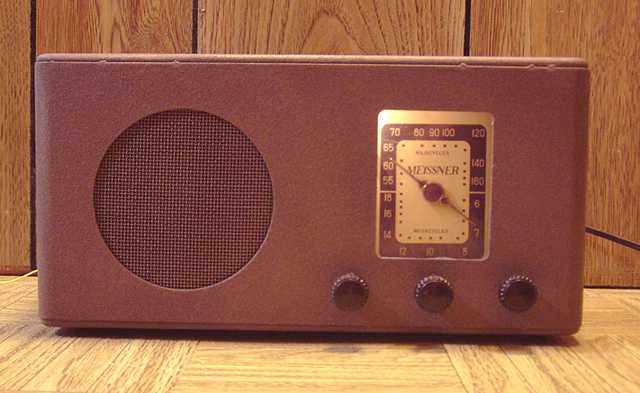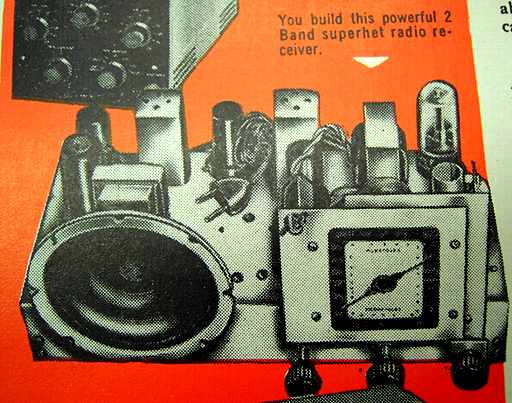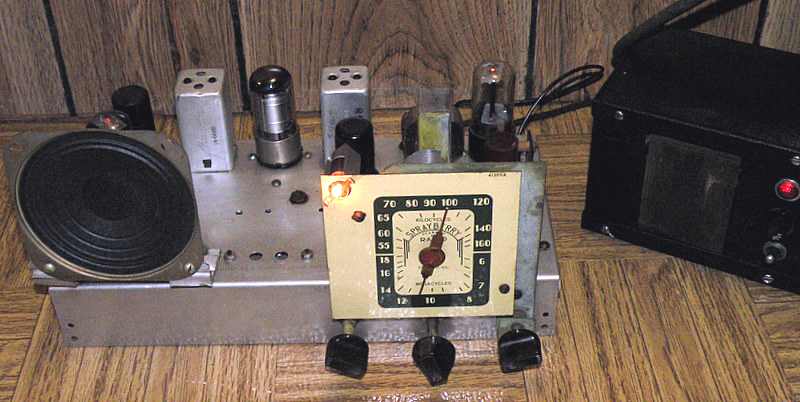
Meissner 9-1085 Broadcast/SW radio
with Sprayberry/ Meissner kit model 10-1199
Update 4-25-09
Sprayberry/ Meissner kit model 10-1199 found and repaired. See below for details.
Meissner 9-1085
The Meissner 9-1085 AM/SW radio is a two-band AC-DC set covering broadcast and shortwave. The design of the radio with its metal cabinet and its 1946 production date suggest strongly that it was intended as a morale radio for purchase by U.S. troops stationed overseas as part of the occupation of the Axis nations immediately following World War II. The set is a variation on the typical AC-DC 5 octal tube set often called an "All-American 5". It includes short wave reception, incorporates a 6th tube for an untuned RF amp stage to improve sensitivity, and an IF wave trap. It also has a power supply choke, seldom seen in typical AC-DC sets. The choke would enable a reduced level of hum from the half-wave power supply especially if it was run from 50 Hz power typical of overseas locations. This set also came with a moisture resistant coating on the paper caps.

Morale radios
Morale radios were built both during and immediately after the war. Those radios were intended for troop entertainment. I make a distinction between morale radios that were primarily targeted for direct sales to troops often with the encouragement of the military, and those that were designed for and purchased by the military itself. I have repaired several of both types of morale radios from that era. One such radio, the Ecophone EC-1, was advertised as available for purchase by soldiers throughout the war despite shortages on the homefront. The advertising was specifically targeted to soldiers.
Toward the end of World War II, and immediately afterwards, right up to the Korean conflict, several companies designed and built radio sets primarily targeted for sale to soldiers stationed overseas. Like the Echophone EC-1, most of those sets were AC-DC to keep costs and weight down. Also, an AC-DC set could be run from nearly any power source. If the voltage was too high, a simple light bulb or two in series could be used to drop the voltage to what was needed. Short wave reception was the norm and cabinets were often metal for sturdiness. Besides the Echophone, another morale radio example sold directly to troops was the Minerva Tropic Master . The Navy itself purchased morale radios such as Crosley's Navy REP/ Pan American Tropical , and the Scott SLRM both of which were also sold to civilians after the war. The Navy's special requirement during the war was avoiding any type of emission from radio receivers that could allow enemy direction finders to home in on their ships. Special low emission morale receivers were required for use on ships. Obviously this was not a major concern for the Army.
Related to a kit version
A variation of this radio was sold as a kit by Meissner. I was convinced that model 9-1085 was a simple upgrade from kit model 10-1199. The kit version is nearly identical but has a hot chassis whereas this model 9-1085 has 2 capacitors and a resistor added to meet floating-ground safety standards. The kit version did not include a cabinet and was also sold without tubes.
The model 10-1199 kit version is written up in detail in A. Frederick Collins, Radio Amateur's Handbook, Ninth Edition, 1949, Thomas Y. Crowell and Co. pages 147-155.


I located a Sprayberry label version of the 10-1199 kit more recently (April 2009).

As noted, the 10-1199 kit version has one side of the power line directly connected to the chassis. The difference between the two and the fact that both were sold in the same era makes me wonder if an agency such as Underwriter's Laboratories decided that floating ground was to be the new minimum safety standard for AC-DC radio sets. Kits may have been exempted from the safety rules. Let me know if you have more exact info.
Schematics
The schematic for model 9-1085 can be found in Rider's volume 15, Meissner page 3.
The schematic and pictorials for the 10-1199 kit can be found in Rider's volume 18, Meissner pages 10-12 as well as in the Collins book and in the Meissner "How to Build" INSTRUCTION MANUAL shown above. Meissner published and sold a number of manuals/ catalogs containing schematics and pictorial images of their kits as well as a wealth of information on the circuits. That complete Meissner "How to Build" INSTRUCTION MANUAL can be downloaded as portions via links on the homepage. Click here for the Meissner link. Model 10-1199 "6 tube AC-DC kit" is on pages 124-127 of the manual.
Electronic condition and repairs. Model 9-1085
I replaced the wax paper cap that bridges the AC input with a more appropriate cap. A couple of other caps were also replaced. After the usual cleaning, this set worked very well on AM Broadcast but could only tune the upper frequencies of the short wave band and poorly at that. After some head scratching and testing, I determined that the 12SA7 oscillator-converter was dropping out on the lower half or so of the shortwave band. Replacing the tube did not change the symptoms. I traced the components in the oscillator circuit which connect to grid number one and the cathode of the 12SA7. The grid leak mica cap fed through a larger 3600 pF mica cap with the bandswitch setting on shortwave. This larger mica was bypassed on the Broadcast band. I rarely suspect mica caps but finally noticed that I could move the larger mica with little effort. One side of the cap was a bit loose on one of its lead wires. That lead was making poor contact with the cap innards. Luckily I had a new 3600 pF dipped mica in the "boxe de junque". That solved the problem. For safety, I polarized the power plug on the 9-1085 and verified that the hot side of the power line went to the power switch and the neutral side to the floating B-.
After an alignment, I listened to shortwave on this surprisingly sensitive little radio. I could imagine an overseas GI and his buddies listening to music and sports from back home via the shortwaves.
The set's wrinkled light chocolate color on its metal cabinet was scratched and scraped. I found a near perfect match in a spray can of Rustoleum autumn brown sold by Walmart.
Condition and repairs. Model 10-1199
Almost 2 years after restoring the model 9-1085 described above, I chanced across the Sprayberry-logo model 10-1199 chassis at a swap meet. It was dirty and had no tubes but the price was right. The aluminum chassis cleaned up nicely. I located tubes for it and used deoxit on the controls. A former owner had replaced the speaker. I replaced it with a better one but used the previous owner's improvised mounting tabs. One electrolytic and several other capacitors later, it was working on the bench fed by my isolation transformer. After a quick alignment, it performed quite well, just like its 9-1085 brother.
The obvious safety warning for model 10-1199
I polarized the line cord plug to try to assure that the side of the power line that connects directly to the chassis always sees the wide-blade neutral side. Nevertheless, I would not operate this set without using an isolation transformer.
Some other Meissner kits
I have repaired other Meissner sets including a Meissner 10-1106 Broadcast TRF radio which was also used as part of the Sprayberry Academy home study course during the late 1930's and the 1940's. Another one was the
Meissner Analyst 9-1040
circuit analyzer which was sold both as a kit and as a finished product. Another Meissner kit is the Signal Shifter EX , an exciter/ VFO for transmitting on the amateur radio bands.
8-07, updated 4-09
The Hallicrafters S-40B receiver was the previous item on the bench. (8-07)